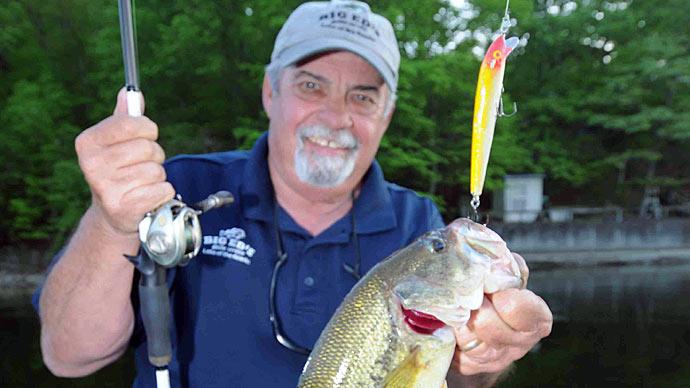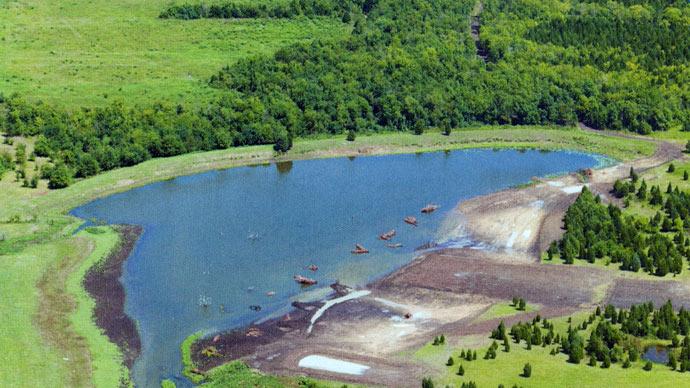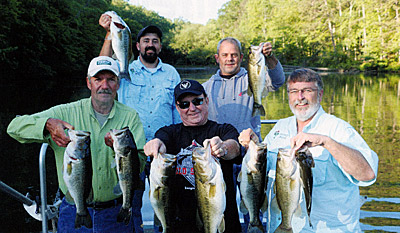
Last spring, an interesting question popped up on the Pond Boss online discussion forum, Ask the Boss. "A friend of mine has a pond overrun with stunted Largemouth bass. He says we could catch a bunch and transfer them to my pond once I stock it next year. My pond is small and freshly drained, dugout and rebuilt - no fish in it. I plan to try to set the pond up as a Bluegill pond using Largemouth bass as the population police. My questions may be moot because a stunted bass population is what I am after, but...Will my friend's stunted bass grow larger if given the environment to grow further? Will their offspring have "small genes" which would limit their growth regardless of environment? With my plans for the bigger Bluegill pond, I could save a few bucks, have a good day of fishing with my friend and help his pond out (a little maybe) by removing some biomass. Your thoughts?"
My advice? Don't do that. It isn't worth the additional consequences. You get one chance to properly stock a pond in the beginning. That's one of my pet peeves. If you take bass that are stunted, yes they can grow, but your originally stocked fish will be the ones with the very best growth potential. If they've lost even half a year, they cannot make that up. The backside of their lives will reflect what they lost during the early part. Better to fillet your friend's fish, make ceviche, deep fry the little darlings, or saute them in olive oil for fish tacos, rather than put them in your pond. Build the food chain, stock young, healthy fish from a known origin, and nurture your pond. You spent good money to build it, use the best fish you can buy to stock it. You'll be glad you did several years down the road.
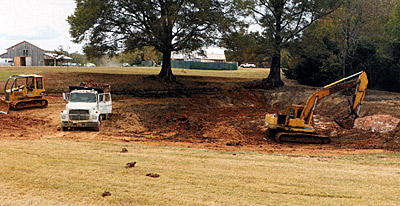
When you do it properly, the bass are the least expensive fish you will stock, considering the numbers and sizes for your stocking plan.
I can't tell you how many times I've looked at a fishery over the years where the landowner did exactly what you are proposing, only to find an out-of-balance fishery with small adults, too many young fish with too little to eat and a puzzled landowner who thought stocking free fish was a good idea.
Just say "No" to the stunted bass. You'll be glad you did when you tie into a hearty four- pound, two-year-old bass growing up in your lake because you were thoughtful all the way through your chain of plans and actions.
You'll still have your big bluegill and achieve what you set out to do, plus some.
Don't scrimp just because they are free.
In the case of the forum question, this pondmeister wants to grow trophy-sized bluegills. So, in theory, he wants to have a stunted bass population, as that's one of the simplest strategies to achieve that goal. Stunted bass eat small bluegills. Bluegills reproduce prolifically, therefore their nature is to overpopulate and stunt. By having too many small bass, they can feasibly control too many small bluegills, leaving only the fittest bluegills to survive and grow to huge sizes.
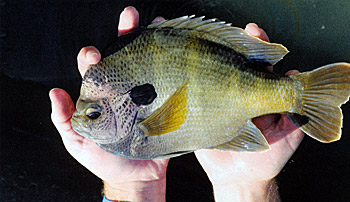
But, if you start off with stunted bass, you eliminate other viable strategies as well. Hear this: Every single lake I've managed that has huge bass also has giant bluegills. Every one of them. And, those lakes have big numbers of big bluegills. Each of those lakes has a feeding program.
The management strategy determines the end gain in a new or newly renovated lake, when it is properly stocked with good genetics and with proper ratios of fish. Listen to that, please. It's not the fish that get you where you want to go. It's how you plan and implement your strategy that will hit the target.
If you stock stunted fish from a neighbor's pond, you have no idea the age of the fish, their heritage, or their health. Plus, throw in the fact those fish are conditioned to that environment, and you have a serious potential to be disappointed. Even worse, you won't even know you're disappointed for two or three years.

There are several reasons this thought process is one of my pet peeves. First, most people go over-budget building their pond or lake, then want to try to save a few dollars with the fish stocking—when their primary objective is to have a fishing pond. I'll never understand that logic, other than people still seem to think that pecans, watermelons, and fish should be free.
On what seems like a daily basis, professional fisheries biologists have to contend with misinformation from well-intentioned neighbors, friends, or people who have stocked a pond—once.
If the goal is to grow huge bluegills, it's more appropriate to stock the pond properly in the beginning. Stock it with 500-1,000, even up to 2,000 bluegills per acre. Good, local genetics from your supplier is wise. Follow that with 50- 100 Largemouth bass fingerlings, if you want. If you want to buy some time, add some larger bluegill that can spawn more quickly, along with advanced fingerling bass.
Here's an important fact to know about creating a fishery. If you stock young fish into new waters, they grow up in that environment. When they grow up in your new waters, they become conditioned to that situation, food chain, habitat, and water quality. Those that become best accustomed are the ones that thrive. If you bring adult fish from another pond, they are conditioned to their original environment, and won't necessarily make the change to yours, even though yours may be better.
As you think through your stocking plan, remember it's based on your timeline and budget. If you are in a hurry, as many people seem to be, then mix the sizes of forage fish and plan to feed them. Those two factors alone will speed up the process.
Your goals and timeline will influence your strategy. If big bluegills are what you are after, then adjust your harvest rate of both bluegills and bass. It's okay to not harvest bass until the fourth or fifth year—if you want to leave big numbers in there to overeat baby bluegills. Overcrowded bass will help you get your bluegills to one pound, maybe a pound and half—if that's what you want. But, if you want truly giant bluegills, that simple strategy isn't the only thing you need to do. You'll also need a great fish food, along with selective harvest of your larger bluegills.
If you follow that strategy, you'll still have an option to grow larger bass as well, which you might want, because big bass prefer big meals, and can assist with the culling of medium-sized bluegills that you otherwise likely won't take. Don't discount using big bass to help achieve your basic goals.
Here's the bottom line.
Every pond deserves the chance to be stocked properly at its beginning. Throwing in a few fish from a neighbor or well-meaning friend doesn't help. At best, it does no damage. But, you eliminate quite a few of the good things that can happen with a proper stocking plan.
Reprinted with permission from Pond Boss Magazine


